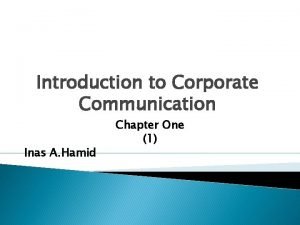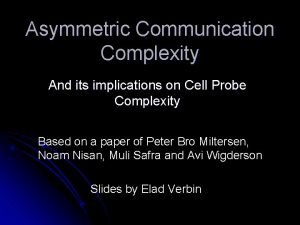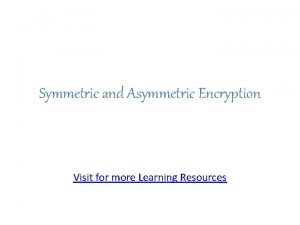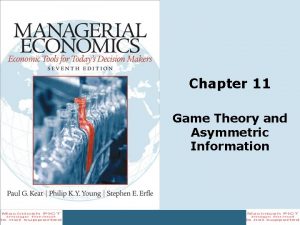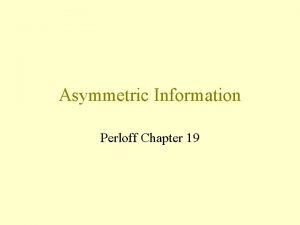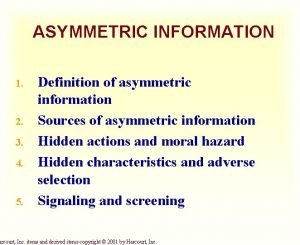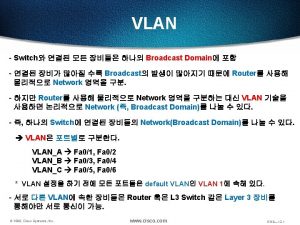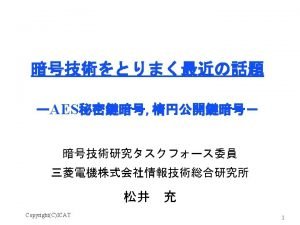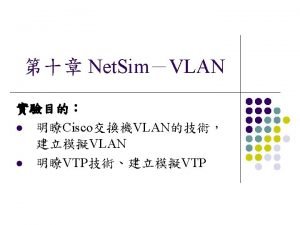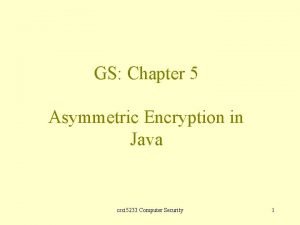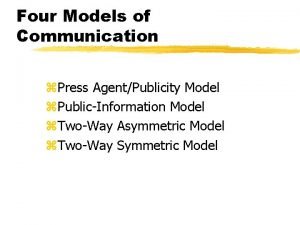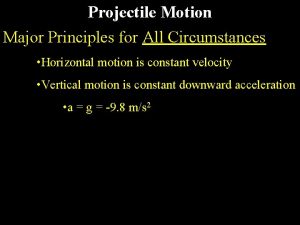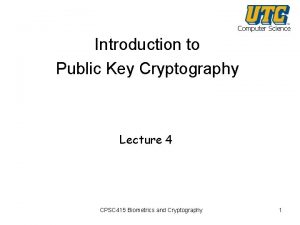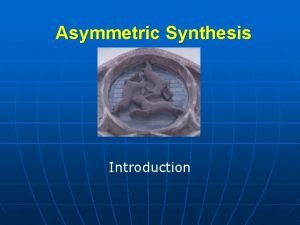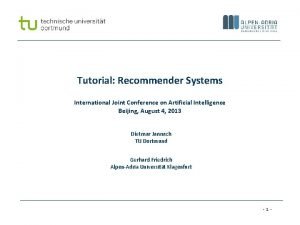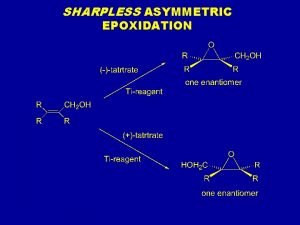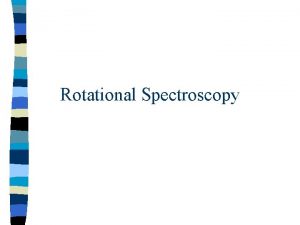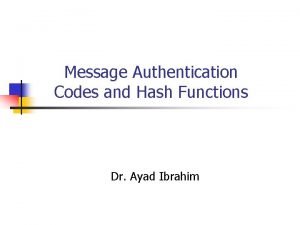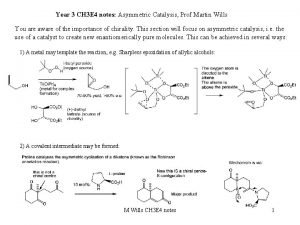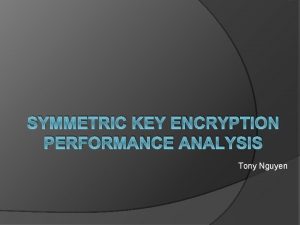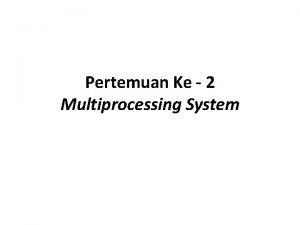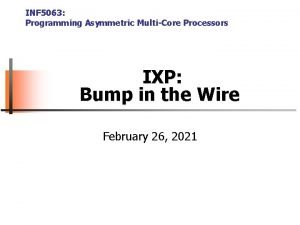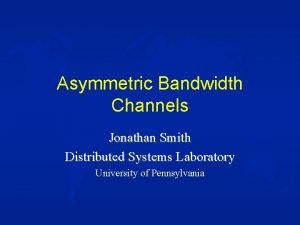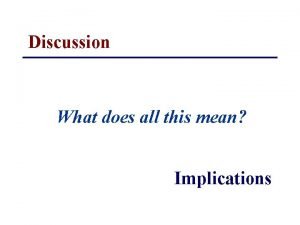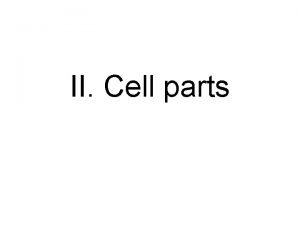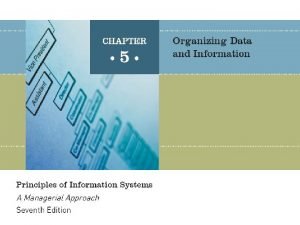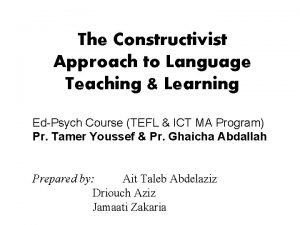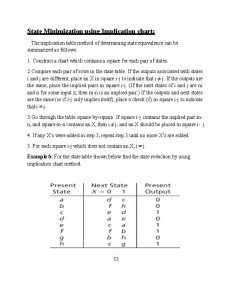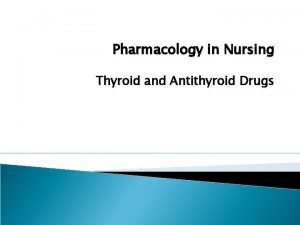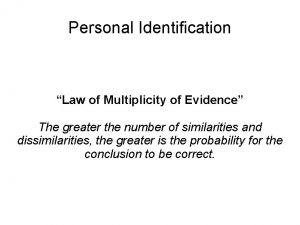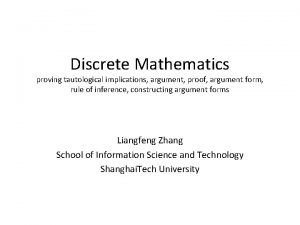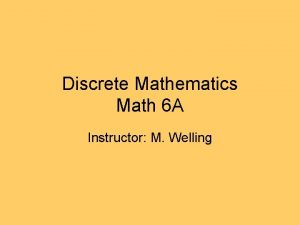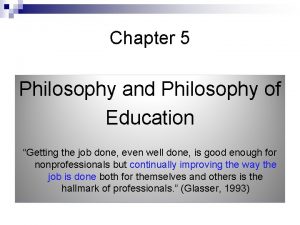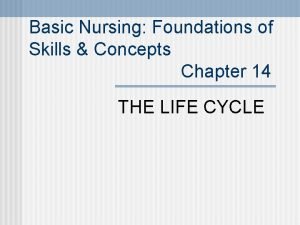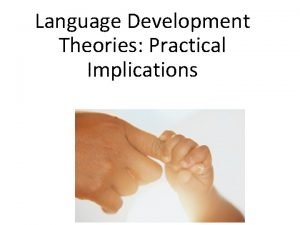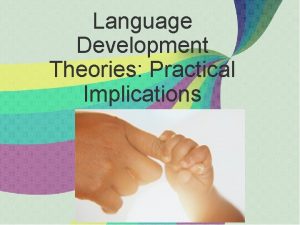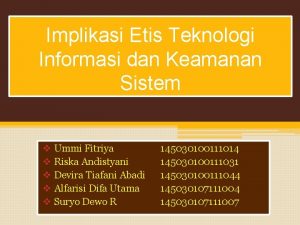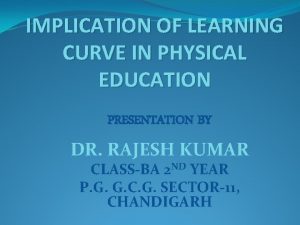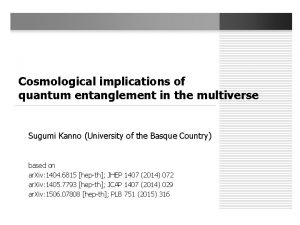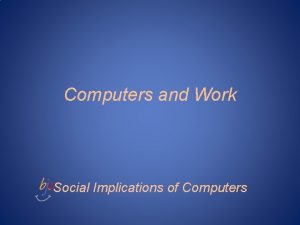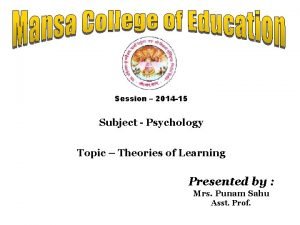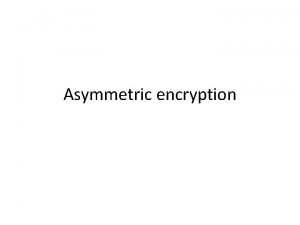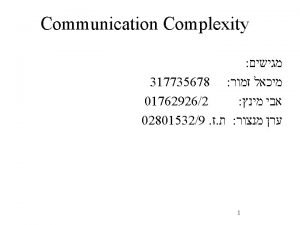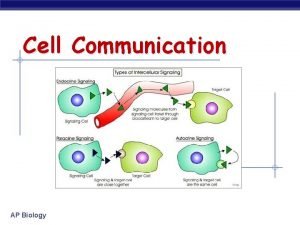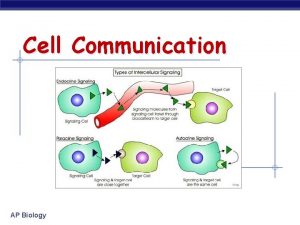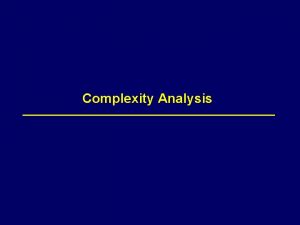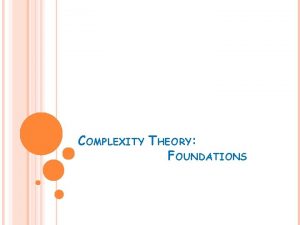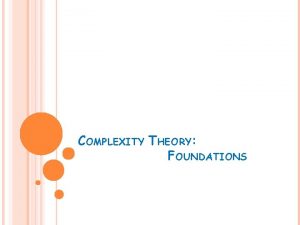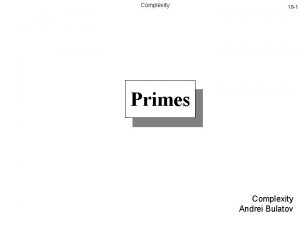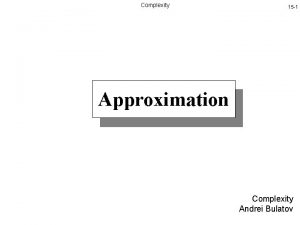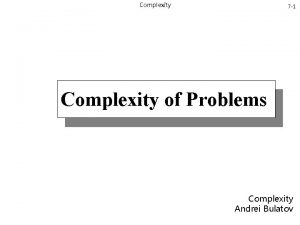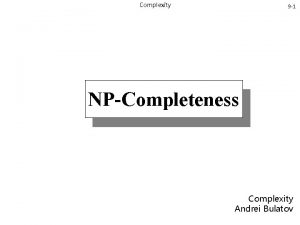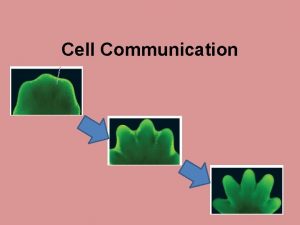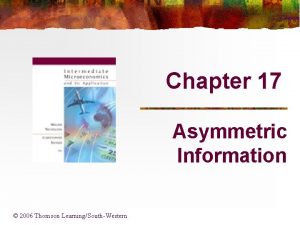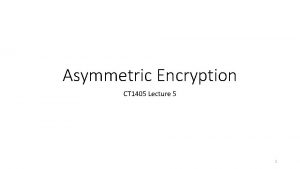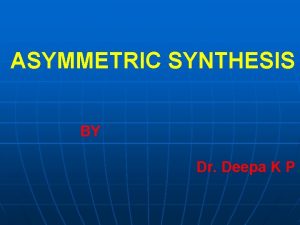Asymmetric Communication Complexity And its implications on Cell







![Example For any problem, there are trivial deterministic protocols: l [log|X|, 1]-protocol l [1, Example For any problem, there are trivial deterministic protocols: l [log|X|, 1]-protocol l [1,](https://slidetodoc.com/presentation_image_h/20919bfdfbe2528d3c15b81a5b3ec4a3/image-8.jpg)

![A one-sided error randomized [O(k), O(l)]-protocol for DISJ(N, k, l) l If we say A one-sided error randomized [O(k), O(l)]-protocol for DISJ(N, k, l) l If we say](https://slidetodoc.com/presentation_image_h/20919bfdfbe2528d3c15b81a5b3ec4a3/image-10.jpg)



![A one-sided error randomized [O(k), O(l)]-protocol for DISJ(N, k, l) l We don’t really A one-sided error randomized [O(k), O(l)]-protocol for DISJ(N, k, l) l We don’t really](https://slidetodoc.com/presentation_image_h/20919bfdfbe2528d3c15b81a5b3ec4a3/image-14.jpg)
![A one-sided error randomized [O(k), O(l)]-protocol for DISJ(N, k, l) l If x and A one-sided error randomized [O(k), O(l)]-protocol for DISJ(N, k, l) l If x and](https://slidetodoc.com/presentation_image_h/20919bfdfbe2528d3c15b81a5b3ec4a3/image-15.jpg)


![The Problem MEMBERSHIP(N) INPUT: a set S [N] l QUERIES: of the form “x The Problem MEMBERSHIP(N) INPUT: a set S [N] l QUERIES: of the form “x](https://slidetodoc.com/presentation_image_h/20919bfdfbe2528d3c15b81a5b3ec4a3/image-18.jpg)
![The Problem MEMBERSHIP(N, n) INPUT: a set S [N] of size n l QUERIES: The Problem MEMBERSHIP(N, n) INPUT: a set S [N] of size n l QUERIES:](https://slidetodoc.com/presentation_image_h/20919bfdfbe2528d3c15b81a5b3ec4a3/image-19.jpg)





![Communication Problem MEM(N, n) l Alice gets x [N], Bob gets y [N], |y|=n, Communication Problem MEM(N, n) l Alice gets x [N], Bob gets y [N], |y|=n,](https://slidetodoc.com/presentation_image_h/20919bfdfbe2528d3c15b81a5b3ec4a3/image-25.jpg)


![Restricted AAC->CP If there is a [O(1), a, b]-protocol for the communication problem then Restricted AAC->CP If there is a [O(1), a, b]-protocol for the communication problem then](https://slidetodoc.com/presentation_image_h/20919bfdfbe2528d3c15b81a5b3ec4a3/image-28.jpg)

![Communication Problem MEM(N, l) l Alice gets x [N], Bob gets y [N], |y|=l, Communication Problem MEM(N, l) l Alice gets x [N], Bob gets y [N], |y|=l,](https://slidetodoc.com/presentation_image_h/20919bfdfbe2528d3c15b81a5b3ec4a3/image-30.jpg)






![Randomized [O(a), O(l/2 a)] Upper Bound for NONMEM(N, l) On the other hand, NONMEM(N, Randomized [O(a), O(l/2 a)] Upper Bound for NONMEM(N, l) On the other hand, NONMEM(N,](https://slidetodoc.com/presentation_image_h/20919bfdfbe2528d3c15b81a5b3ec4a3/image-37.jpg)
![Tightness for NONMEM(N, l) l NONMEM(N, l) has a [O(a), O(l/2 a)]-protocol, for all Tightness for NONMEM(N, l) l NONMEM(N, l) has a [O(a), O(l/2 a)]-protocol, for all](https://slidetodoc.com/presentation_image_h/20919bfdfbe2528d3c15b81a5b3ec4a3/image-38.jpg)





![Proof of the Richness Lemma Let X = #{1 s in S} l E[X]>=2/3 Proof of the Richness Lemma Let X = #{1 s in S} l E[X]>=2/3](https://slidetodoc.com/presentation_image_h/20919bfdfbe2528d3c15b81a5b3ec4a3/image-44.jpg)










![General framework for LB proofs using the Round Elimination Lemma [t, a, b]-protocol for General framework for LB proofs using the Round Elimination Lemma [t, a, b]-protocol for](https://slidetodoc.com/presentation_image_h/20919bfdfbe2528d3c15b81a5b3ec4a3/image-55.jpg)


![GT(n) does not have a [t, n 1/t. C-t]-protocol l Theorem: Let C=99. There GT(n) does not have a [t, n 1/t. C-t]-protocol l Theorem: Let C=99. There](https://slidetodoc.com/presentation_image_h/20919bfdfbe2528d3c15b81a5b3ec4a3/image-58.jpg)
![GT(n) does not have a [t, n 1/t. C-t]-protocol l By induction on t GT(n) does not have a [t, n 1/t. C-t]-protocol l By induction on t](https://slidetodoc.com/presentation_image_h/20919bfdfbe2528d3c15b81a5b3ec4a3/image-59.jpg)
![GT(n) does not have a [t, n 1/t. C-t, n 1/t. C-t]-protocol for GT(n) GT(n) does not have a [t, n 1/t. C-t, n 1/t. C-t]-protocol for GT(n)](https://slidetodoc.com/presentation_image_h/20919bfdfbe2528d3c15b81a5b3ec4a3/image-60.jpg)

- Slides: 61

Asymmetric Communication Complexity And its implications on Cell Probe Complexity Based on a paper of Peter Bro Miltersen, Noam Nisan, Muli Safra and Avi Wigderson Slides by Elad Verbin

Purpose We want to get Lower Bounds. Best known lower bounds: l Sorting is Ω(nlogn) in the comparison model l Trivial lower bounds. i. e. MAX is Ω(n) l What can we really do, i. e. for RAM?

Outline Yao decided to strengthen the model – Considered the Cell Probe model. l Lower bounding Cell Probe is hard too. We strengthen even more – Communication Complexity l

Outline l l 1. 2. We show the relationship between Cell Probe and Communication Complexity. We show to get lower bounds for Communication Complexity using two techniques: The Richness Technique The Round Elimination Technique

Communication Complexity The problem : f: X Y {0, 1} l Alice gets x X, Bob gets y Y, their goal is to exchange messages to decide f(x, y). l f(x, y) l A solution is a communication protocol that can compute f(x, y) for all x, y.

Asymmetric Communication Complexity l A Communication Protocol that computes function f in which Alice sends at most a bits and Bob sends at most b bits is called a [a, b]-protocol for f. Pink<=a f(x, y) Blue<=b

Randomized Protocols If the protocol is allowed to flip (public) coins, and gives the correct answer with probability > 2/3 it is called a randomized protocol. l If it always correctly identifies a 0 -instance it is called a one-sided error protocol. l
![Example For any problem there are trivial deterministic protocols l logX 1protocol l 1 Example For any problem, there are trivial deterministic protocols: l [log|X|, 1]-protocol l [1,](https://slidetodoc.com/presentation_image_h/20919bfdfbe2528d3c15b81a5b3ec4a3/image-8.jpg)
Example For any problem, there are trivial deterministic protocols: l [log|X|, 1]-protocol l [1, log|Y|]-protocol. l

The Problem DISJ(N, k, l) We work on the universe U={0, 1, …, N-1} l Alice gets x, a set of k elements l Bob gets y, a set of l elements l They must decide if x∩y=Ø l x y x∩y=Ø? =Ø
![A onesided error randomized Ok Olprotocol for DISJN k l l If we say A one-sided error randomized [O(k), O(l)]-protocol for DISJ(N, k, l) l If we say](https://slidetodoc.com/presentation_image_h/20919bfdfbe2528d3c15b81a5b3ec4a3/image-10.jpg)
A one-sided error randomized [O(k), O(l)]-protocol for DISJ(N, k, l) l If we say that x and y are disjoint then we want to have complete confidence. If we say they intersect, we want to be reasonably certain. l Flip public coins to get a sequence of random subsets of the universe: R 1, R 2, …

x y R 3

x y R 3 y=y∩R 3 y

x y R 3 y=y∩R 3 R 8 x=x∩R 8 AND SO ON…. y
![A onesided error randomized Ok Olprotocol for DISJN k l l We dont really A one-sided error randomized [O(k), O(l)]-protocol for DISJ(N, k, l) l We don’t really](https://slidetodoc.com/presentation_image_h/20919bfdfbe2528d3c15b81a5b3ec4a3/image-14.jpg)
A one-sided error randomized [O(k), O(l)]-protocol for DISJ(N, k, l) l We don’t really send the index of R 8, we just send the distance from the last set (83=5). This means that the expected numbers of bits sent by a player is equal to the size of his set l If at some point one of the sets becomes empty, then the originals were disjoint – say so. Otherwise, after a long time, say that there is an intersection.
![A onesided error randomized Ok Olprotocol for DISJN k l l If x and A one-sided error randomized [O(k), O(l)]-protocol for DISJ(N, k, l) l If x and](https://slidetodoc.com/presentation_image_h/20919bfdfbe2528d3c15b81a5b3ec4a3/image-15.jpg)
A one-sided error randomized [O(k), O(l)]-protocol for DISJ(N, k, l) l If x and y were indeed disjoint, the sizes of x and y decrease by a factor of 2 each round. Therefore the total communication is [O(k), O(l)]. l If the sets were disjoint, what is the chance that we say that there is an intersection? Very low.

Fixed-round protocols l If t alternating messages are sent and each message is of size a or b it is called a [t, a, b]-protocol. a b a t b f(x, y)

Static Data Structure Problems l l A static data structure problem is a function f: D Q R D – the data Q – the queries R – Possible answers. Typically, R={0, 1} DS Data query
![The Problem MEMBERSHIPN INPUT a set S N l QUERIES of the form x The Problem MEMBERSHIP(N) INPUT: a set S [N] l QUERIES: of the form “x](https://slidetodoc.com/presentation_image_h/20919bfdfbe2528d3c15b81a5b3ec4a3/image-18.jpg)
The Problem MEMBERSHIP(N) INPUT: a set S [N] l QUERIES: of the form “x S? ” l D={S [N]}, |D|=2 N l Q=[N] l R={0, 1} l l The trivial solution is optimal.
![The Problem MEMBERSHIPN n INPUT a set S N of size n l QUERIES The Problem MEMBERSHIP(N, n) INPUT: a set S [N] of size n l QUERIES:](https://slidetodoc.com/presentation_image_h/20919bfdfbe2528d3c15b81a5b3ec4a3/image-19.jpg)
The Problem MEMBERSHIP(N, n) INPUT: a set S [N] of size n l QUERIES: of the form “x S? ” l D={S [N] | |S|=n}, |D|=choose(N, n) l Q=[N] l R={0, 1} l

The Cell Probe Model Parameter w – word size l s cells, each containing w bits. l Each query probes at most t cells to get answer l l A query is a decision tree of depth t and degree 2 w

MEMBERSHIP(N, n) Solutions: l Keep every possible answer. s=N, t=1 (better – s=N/w, t=1) l Keep a nonredundant representation. s=log(choose(N, n)), t=log(choose(N, n))

MEMBERSHIP(N, n) Solutions: l Keep a sorted list of all elements. s=nlog(N)/w , t=log(n)*log(N)/w l There is a randomized solution with s=(n/w)c, t=O(1), for some constant c.

What is the connection between Cell Probe and Asymmetric Communication Complexity?

ACC <-> Cell Probe l The communication problem related to a static data structure problem f: D Q {0, 1} if the problem where Alice gets a query, Bob gets the data, and they should decide if this is a “yes” instance or a “no” instance
![Communication Problem MEMN n l Alice gets x N Bob gets y N yn Communication Problem MEM(N, n) l Alice gets x [N], Bob gets y [N], |y|=n,](https://slidetodoc.com/presentation_image_h/20919bfdfbe2528d3c15b81a5b3ec4a3/image-25.jpg)
Communication Problem MEM(N, n) l Alice gets x [N], Bob gets y [N], |y|=n, they should decide if x y. l Trivial protocols: [1, nlog. N] , [log. N, 1]

Lemma CP->AAC If there is a solution to the data structure problem with word size w taking s cells and with query time t, then there is a [2 t, log(s), w]-protocol for the communication problem Therefore a lower bound on ACC gives us a lower bound on Cell Probe

Finer points of CP->AAC How is the communication complexity model stronger than the Cell Probe Model? l Answer: In its adaptivity l Which form of Cell Probe lower bounds can we get from the CP->AAC Lemma? l Answer: the bound on space is up to a polynomial l
![Restricted AACCP If there is a O1 a bprotocol for the communication problem then Restricted AAC->CP If there is a [O(1), a, b]-protocol for the communication problem then](https://slidetodoc.com/presentation_image_h/20919bfdfbe2528d3c15b81a5b3ec4a3/image-28.jpg)
Restricted AAC->CP If there is a [O(1), a, b]-protocol for the communication problem then the data structure problem has a solution with word size w=b, t=O(1) and s=2 O(a) Proof: The Data Structure for input y contains the message Bob should send next for every possible history of messages Alice can send, for any query.

Lower Bounding The Communication Complexity
![Communication Problem MEMN l l Alice gets x N Bob gets y N yl Communication Problem MEM(N, l) l Alice gets x [N], Bob gets y [N], |y|=l,](https://slidetodoc.com/presentation_image_h/20919bfdfbe2528d3c15b81a5b3ec4a3/image-30.jpg)
Communication Problem MEM(N, l) l Alice gets x [N], Bob gets y [N], |y|=l, they should decide if x y. l NONMEM(N, l) is the same problem, when Alice and Bob want to decide if x y l Trivial protocols: [1, l*log. N] , [log. N, 1]

Problem <-> Matrix l We identify a communication problem f: X×Y {0, 1} with a |X|×|Y| Matrix where M[x][y]=f(x, y). l The matrix of NONMEM(N, l) has N rows and columns. Each column has N-l 1 entries

Problem <-> Matrix l A problem (matrix) is (u, v)-rich if at least v columns contain at least u 1 -entries. (4, 3)-rich l NONMEM(N, l) is (N-l, )-rich.

The Richness Lemma l 1. 2. l Let f be a communication problem that: is (u, v)-rich has a randomized one-sided error [a, b]protocol. Then f contains a u/2 a+2 over v/2 a+b+2 submatrix of 1 -entries.

Randomized Lower Bound for MEM(N, l) l Say MEM(N, l) has a negative-one-sided error [a, b]-protocol. Let a<log(l), l<N/2. l Then NONMEM(N, l) has a one-sided error [a, b]-protocol

Randomized Lower Bound for NONMEM(N, l) l NONMEM(N, l) is (N-l, )-rich l Therefore it has a 1 -submatrix of dimensions at least (N-l)/2 a+2 over /2 a+b+2

Randomized Lower Bound for NONMEM(N, l) l However, if there is a 1 -submatrix of dimensions r on s then s≤ l By substituting for s and r, simplifying and bounding we get 2 a(a+b)=Ω(l)
![Randomized Oa Ol2 a Upper Bound for NONMEMN l On the other hand NONMEMN Randomized [O(a), O(l/2 a)] Upper Bound for NONMEM(N, l) On the other hand, NONMEM(N,](https://slidetodoc.com/presentation_image_h/20919bfdfbe2528d3c15b81a5b3ec4a3/image-37.jpg)
Randomized [O(a), O(l/2 a)] Upper Bound for NONMEM(N, l) On the other hand, NONMEM(N, l) has a [O(a), O(l/2 a)]-protocol, for all a<log(l): l Alice sends Bob the first a indices of R’s that contain x. This allows Bob to reduce y to expected size l/2 a. l Then Bob sends a couple indices that contain y. l If we are not yet sure that they are disjoint, we say that they intersect. l
![Tightness for NONMEMN l l NONMEMN l has a Oa Ol2 aprotocol for all Tightness for NONMEM(N, l) l NONMEM(N, l) has a [O(a), O(l/2 a)]-protocol, for all](https://slidetodoc.com/presentation_image_h/20919bfdfbe2528d3c15b81a5b3ec4a3/image-38.jpg)
Tightness for NONMEM(N, l) l NONMEM(N, l) has a [O(a), O(l/2 a)]-protocol, for all a<log(l) l 2 a(a+b)= 2 a(a+l/2 a)=? O(l) Therefore the last result is tight? l There are constants c, c’>0, so that for any a, b=l/2 ca is enough. b=l/2 c’a is not enough. l l

The Richness Lemma l 1. 2. l Let f be a communication problem that: is (u, v)-rich has a randomized one-sided error [a, b]protocol. Then f contains a u/2 a+2 over v/2 a+b+2 submatrix of 1 -entries.

Proof of the Richness Lemma l First let us prove a weaker result: if f has a deterministic [a, b]-protocol then it contains a u/2 a over v/2 a+b submatrix of 1 -entries. l We prove this by induction on a+b:

Proof of the Richness Lemma For a+b=0 – |X|≥u, |Y|≥v, and f(x, y)=1 for all x, y, so this is trivial. l Now, if Alice send the first bit: l X 0 – inputs for which she sends 0 l X 1 – inputs for which she sends 1 l Let f 0, f 1 be the restrictions of f to X 0 Y, X 1 Y. l

Proof of the Richness Lemma At least one of them is (u/2, v/2)-rich, and both have a [a-1, b] protocol. l By the induction it contains a (u/2)/2 a-1 over (v/2)/2 a+b-1 1 -submatrix. l In the other case, Bob send the first bit. l Define Y 0, Y 1, f 0, f 1. At least one of them is (u, v/2)-rich, and proceed similarly. l

Proof of the Richness Lemma Now let us prove the general case: l Let S be the set of u*v rich-positions in the matrix l Let us look at some coin-flip sequence. l
![Proof of the Richness Lemma Let X 1 s in S l EX23 Proof of the Richness Lemma Let X = #{1 s in S} l E[X]>=2/3](https://slidetodoc.com/presentation_image_h/20919bfdfbe2528d3c15b81a5b3ec4a3/image-44.jpg)
Proof of the Richness Lemma Let X = #{1 s in S} l E[X]>=2/3 * uv l => There exists such a sequence for which X>=2/3 * uv l l Fix the sequence, to get a deterministic algorithm. This algorithm computes a function f’ that is close to f.

Proof of the Richness Lemma l By a counting argument, f’ is (u/4, v/4)-rich, and so it has a 1 -submatrix of the required size ( u/2 a+2 over v/2 a+b+2 ) l This is a 1 -submatrix in f too, because the error is one-sided. l Q. E. D.

A Richness Results for two-sided error l Let d, e>0, and let f: X×Y {0, 1} be a communication problem with at least a dfraction of 1 s. If f has a randomized twosided error [a, b]-protocol then f has a submatrix M of dimensions at least |X|/2 O(a) over |Y|/2 O(a+b) with at least a (1 -e)fraction of 1 s.

The SPAN(n) Problem In SPAN, Alice gets x {0, 1}n and Bob gets a vector subspace y {0, 1}n l y can be represented using a basis of k≤n vectors – O(n 2) bits l Alice and Bob must decide if x∈y. l l Trivial Protocols: [n, 1] , [1, n 2]

Lower bounds for SPAN l l l 1. 2. Let’s prove that in any [a, b] randomized one-sided error protocol for SPAN, either a=Ω(n), or b=Ω(n 2) We will assume that y is of dimension n/2. We will prove that: 2/4 n/2 n SPAN is (2 , 2 )-rich, and SPAN does not contain a 1 -submatrix 2/12 n/3 n of dimensions 2 over 2

SPAN is 2/4 n/2 n (2 , 2 )-rich Each subspace contains exactly 2 n/2 vectors => each column contains 2 n/2 1 s. l How many subspaces of dimension n/2 are there? l Lets choose a basis: we have 2 n-1 possibilities for the first vector, 2 n-2 for the second, 2 n-4 for the third, etc. l

SPAN is 2/4 n/2 n (2 , 2 )-rich We chose each basis (n/2)! times l How many basis does a subspace has? l We have 2 n/2 -1 options to choose the first vector, 2 n/2 -2 for the second, etc. l We again chose each basis (n/2)! times. l l Thus, there at least dimension n/2. 2/4 n 2 subspaces of

SPAN does not contain a 1 -submatrix 2/12 n/3 n of dimensions 2 over 2 Lets look at a 1 -submatrix with at least 2 n/3 rows. The subspace spanned by them is of dimension at least n/3. l How many subspaces of dimension n/2 can include this entire subspace? l 2/12 n l 2 l And we’re done.

The Round Elimination Lemma

f->Pm(f) l Let f: X×Y->{0, 1} be a communication problem l l Pm(f) is: Alice gets m elements from X, x 1, …, xm Bob gets 1≤i≤m, y Y and also x 1, …, xi-1 They want to compute f(xi, y) l How meaningful can Alice’s first message be? l l

The Round Elimination Lemma Let C=99, R=4256. l Say that PRa(f) has a randomized twosided error [t, a, b]-protocol in which Alice sends the first message. l Then there is a randomized two-sided error [t-1, Ca, Cb]-protocol with Bob sending the first message. l
![General framework for LB proofs using the Round Elimination Lemma t a bprotocol for General framework for LB proofs using the Round Elimination Lemma [t, a, b]-protocol for](https://slidetodoc.com/presentation_image_h/20919bfdfbe2528d3c15b81a5b3ec4a3/image-55.jpg)
General framework for LB proofs using the Round Elimination Lemma [t, a, b]-protocol for F(n) [t, a, b]-protocol for Pm(F(n’)) (typically n’=n/m) [t-1, Ca, Cb]-protocol for F(n’) [1, Ct-1 a, Ct-1 b]-protocol for F(n(t-1))

The problem GT(n) Alice and Bob each gets an n-bit integer. l They want to decide if x<y. l x y x<y?

The problem GT(n) Deterministic communication complexity is linear l Randomized comm. complexity with twosided error is O(logn) (using a logarithmic number of rounds) l l When limited to t rounds: There is a [t, n 1/tlogn]-protocol
![GTn does not have a t n 1t Ctprotocol l Theorem Let C99 There GT(n) does not have a [t, n 1/t. C-t]-protocol l Theorem: Let C=99. There](https://slidetodoc.com/presentation_image_h/20919bfdfbe2528d3c15b81a5b3ec4a3/image-58.jpg)
GT(n) does not have a [t, n 1/t. C-t]-protocol l Theorem: Let C=99. There does not exist a randomized twosided error [t, n 1/t. C-t]-protocol for GT(n)
![GTn does not have a t n 1t Ctprotocol l By induction on t GT(n) does not have a [t, n 1/t. C-t]-protocol l By induction on t](https://slidetodoc.com/presentation_image_h/20919bfdfbe2528d3c15b81a5b3ec4a3/image-59.jpg)
GT(n) does not have a [t, n 1/t. C-t]-protocol l By induction on t Say there was a [t, n 1/t. C-t]-protocol for GT(n). l Then there is a [t, n 1/t. C-t]-protocol for Pm(GT(n’)) for m=n 1/t, n’=n(t-1)/t l From the round Elimination Lemma, there is a [t-1, n 1/t. C-(t-1)]-protocol for GT(n’). Contradiction. l
![GTn does not have a t n 1t Ct n 1t Ctprotocol for GTn GT(n) does not have a [t, n 1/t. C-t, n 1/t. C-t]-protocol for GT(n)](https://slidetodoc.com/presentation_image_h/20919bfdfbe2528d3c15b81a5b3ec4a3/image-60.jpg)
GT(n) does not have a [t, n 1/t. C-t, n 1/t. C-t]-protocol for GT(n) [t, n 1/t. C-t]-protocol for Pm(GT(n’)) for m=n 1/t, n’=n(t-1)/t l l l Alice constructs a n-bit integer x’: She concatenates x 1…xm Bob constructs a n-bit integer y’: He concatenates x 1…xi-1 then y and the rest is 1 s We get x’>y’ xi>y

THE END
 Space complexity of nested loops
Space complexity of nested loops Asymmetric communication
Asymmetric communication Asymmetric communication
Asymmetric communication Symmetric and asymmetric matrix
Symmetric and asymmetric matrix Disadvantages of asymmetric encryption
Disadvantages of asymmetric encryption Iugr causes
Iugr causes Asymmetric information game theory
Asymmetric information game theory Asymmetric vlan
Asymmetric vlan Asymmetric information diagram
Asymmetric information diagram Asymmetric information diagram
Asymmetric information diagram Vlan id 4095
Vlan id 4095 Strategic view of ihrm
Strategic view of ihrm Des aes
Des aes Asymmetric vlan
Asymmetric vlan Asymmetric vlan
Asymmetric vlan Key distribution center
Key distribution center Asymmetric encryption java
Asymmetric encryption java Two-way asymmetric model
Two-way asymmetric model Sunil gupta actor
Sunil gupta actor Algogenic
Algogenic Projectile motion principles
Projectile motion principles Cryptography computer science
Cryptography computer science Asymmetric synthesis example
Asymmetric synthesis example Asymmetric dominance effect
Asymmetric dominance effect Sharpless asymmetric epoxidation
Sharpless asymmetric epoxidation Selection rule for raman spectroscopy
Selection rule for raman spectroscopy Asymmetric key authentication
Asymmetric key authentication Asymmetric synthesis notes
Asymmetric synthesis notes Symmetric vs asymmetric encryption performance
Symmetric vs asymmetric encryption performance Contoh multiprocessor
Contoh multiprocessor Extreme spbm
Extreme spbm Asymmetric multicore processing
Asymmetric multicore processing Asymmetric bandwidth
Asymmetric bandwidth Discussion and implications
Discussion and implications The emigree key themes
The emigree key themes Its halloween its halloween the moon is full and bright
Its halloween its halloween the moon is full and bright Cell
Cell Draw and label the parts of the egg
Draw and label the parts of the egg Characteristics of database approach
Characteristics of database approach Social constructivist meaning
Social constructivist meaning Implication chart
Implication chart Nursing implications for synthroid
Nursing implications for synthroid State the 2 law of multiplicity of evidence
State the 2 law of multiplicity of evidence Media have commercial implications
Media have commercial implications Marketing implications
Marketing implications Tautological implications
Tautological implications Implication math examples
Implication math examples 5 philosophies of education
5 philosophies of education Cengage learning
Cengage learning Nursing implications
Nursing implications Educational implications examples
Educational implications examples Legal implications of social media
Legal implications of social media Implications of nativist theory
Implications of nativist theory Implications of nativist theory
Implications of nativist theory Implikasi etis adalah
Implikasi etis adalah Educational implications of learning curve
Educational implications of learning curve Implications of quantum entanglement
Implications of quantum entanglement Social implications of computers
Social implications of computers Legal implications of nursing documentation
Legal implications of nursing documentation Ranexa nursing implications
Ranexa nursing implications Glargine nursing implications
Glargine nursing implications S-r bond theory
S-r bond theory

